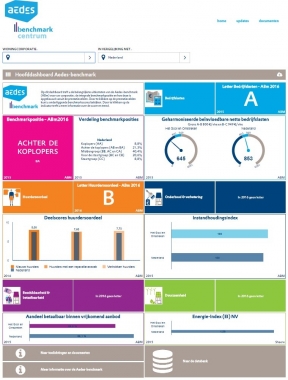Transparent and efficient social housing
The case of the Aedes Benchmark
The Hague, 3 October 2017 | Social, Economy
November is an exciting month for social housing providers in the Netherlands. Every year, with a mix of hope and anxiety, it is when the results of the Aedes-Benchmark are published. This year will be the fourth edition after the benchmark was launched in 2014. The benchmark was introduced to make sure social housing corporations stay alert and learn from colleague corporations. It was a reaction to a series of incidents that plagued the sector around 2010. The sector came under public and political pressure to improve its performances and the level of transparency. The benchmark has proven to be a valuable instrument since then.
By Sander Koomen and Sébastien Garnier
Learning and accountability
The main goal of the benchmark instrument is for Aedes members to learn from each other and provide a tool for further development and policy choices. The benchmark puts pressure on housing corporations to continuously improve their performance.
Furthermore, the results of the benchmark are made transparent. It is one of the few sectoral benchmarks which results are made fully public.
This disclosure of individual performances was a big step for many members, but it led to much goodwill from government and stakeholders. Corporations openly showed how they perform and explain how they work on improvements.
Comparing performance is one thing, but the results are also an important starting point for discussions with (internal and external) supervisors, local authorities, tenant organizations and other stakeholders. The benchmark serves to stimulate constructive dialogues with management.
Furthermore, Aedes uses the benchmark as a management tool to monitor developments in the sector and use the general outcomes in discussions with decision-makers. Finally, the improvement of the data quality in the sector was a welcome side effect as well.
How does the benchmark work?
1. First, Aedes put a lot of effort in developing the benchmark model. They did this together with housing corporations and key stakeholders (tenants, municipalities, ministry, regulator, sector fund). This model provides which ‘performance fields’ are measured in the benchmark.
2. Then, Aedes gathers professionals from of housing corporations in working groups to develop the different performance fields: what is exactly being measured and which data is needed and available? From the start, Aedes members are actively involved in the development. More than 150 professionals from housing corporations participate annually in one of the different working groups.
3. Aedes is collecting data. To keep the burden for corporations as low as possible, the optimal use of existing data is highly preferred. Additional data is only requested from corporations when existing figures are incomplete or not sufficiently comparable to benchmark.
4. The next step is to validate, merge, analyse and interpret the data. This is also done together with the relevant experts from housing corporations and stakeholders.
5. In November of each year, Aedes publishes a report with the end results at sectoral level and the most important results per corporation. These are made available through the Aedes website. In addition, each corporation can consult all the benchmark results through an individual dashboard available through the Aedes- Benchmark Centre.
6. Finally, housing corporations start working with the results. They define their improvement potential and develop plans on this basis. The benchlearning program offered through Aedes can help them in this stage. The results also initiate discussions with supervisors and stakeholders.
Performance fields and indicators
The Aedes-benchmark is based on five performance fields. These performance fields are typical items for any management plan. Each performance field consists of several partial scores and indicators. In addition, variables are used for analysis purposes, for example about the role of organisational structures of corporations. In total there are hundreds of indicators per corporation within the Aedes-benchmark.
The five performance fields of the Aedes-benchmark are:
- "Tenants evaluation" deals with the satisfaction of tenants on a number of primary processes (entering and leaving the dwelling, repair requests).
- “Operating expenses” is about costs (staff, office, ICT) made to achieve core results.
- “Maintenance & Improvement” costs of dwellings is a field that is also being linked to tenants' appraisal of housing quality and the technical quality of dwellings.
- “Sustainability” addresses the energy performance of dwellings and CO2 emissions.
- "Availability & Affordability" addresses the social performance that a corporation provides to offer affordable housing.
Results
The benchmark has become a valuable instrument that is widely accepted in the sector. Although not mandatory, many corporations are represented in the benchmark. In 2017, 89% of all 339 housing corporations participated. They represent 98% of all dwellings in the sector. In addition, more than 600 employees joined one of 50 benchlearning meetings organized by Aedes.
The effects of the benchmark are visible. As an example, corporate operating expenses have fallen by about 20% over the past year and the satisfaction of tenants about the services has improved. Although the exact effect is difficult to measure, the benchmark undeniably contributed to this.
Aedes also received positive feedback from professionals who enjoy participating in working groups and talk with their pears on very specific management or operational issues.
Future
Because of the great success, Aedes wants to continue with its benchmark and related activities. The focus for the future is to continue increasing added value for members and stakeholders by expanding the benchmark learning program and increasing policy-relevant outcomes from the benchmark.
Leave comments